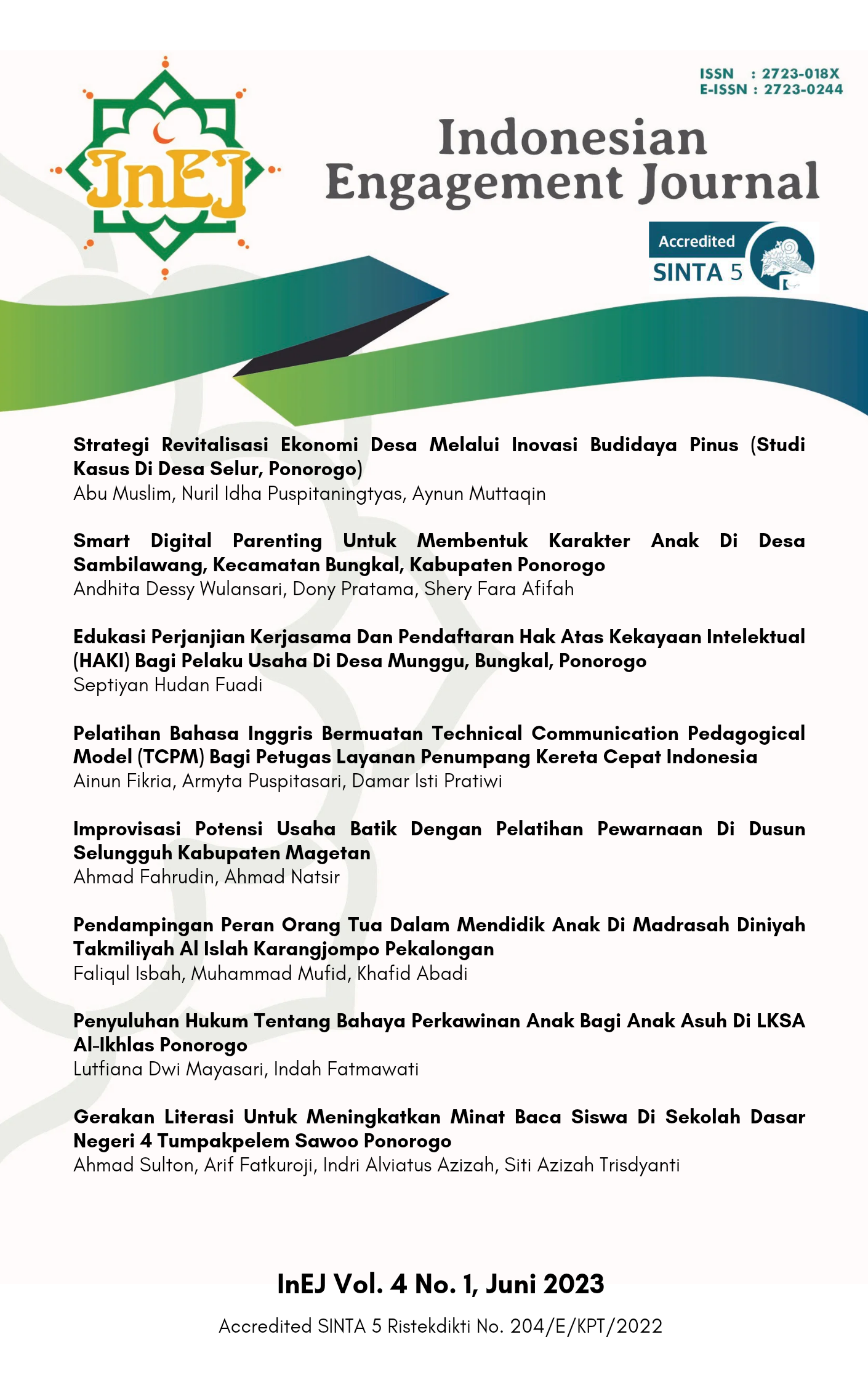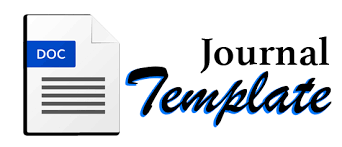IMPROVISASI POTENSI USAHA BATIK DENGAN PELATIHAN PEWARNAAN DI DUSUN SELUNGGUH KABUPATEN MAGETAN
DOI:
https://doi.org/10.21154/inej.v4i1.5894Keywords:
Batik, ABCD, Selungguh, ImprovisasiAbstract
PKK merupakan sebuah komunitas yang cukup berpengaruh pada masyarakat dusun Selungguh. Pengaruh ini dibuktikan dengan mapping komunitas (community mapping) yang dilakukan oleh peneliti bersama masyarakat setempat. Hal ini ditambah dengan program yang digadang-gadang aparatur desa setempat sebagai program unggulan desa Kediren. Program tersebut ialah Produksi kain batik yang ada di Dusun selungguh. Metode yang digunakan pada pengabdian ini adalah ABCD (Asset Based Community Development). Pada akhirnya, peneliti memilih produksi kain batik Selungguh sebagai potensi yang laik untuk dilakukan improvisasi dengan pelatikan colouring pada kain batik yang mereka hasilkan. Dengan pelatihan ini diharapkan segenap masyarakat mampu meningkatkan kualitas produksi kain batik yang merekahasilkan.
References
Alifiana, Mia. “Peningkatan Pendapatan Rumah Tangga Melalui Pemberdayaan Ibu-Ibu PKK.” Journal of Dedicators Community 2, no. 2 (2018): 83”“90.
Edi Eskak. “Mendorong Kreativitas Dan Cinta Batik Pada Generasi Muda Kritik Seni Karya Pemenang Lomba Desain Batik BBKB 2012.” Dinamika Kerajinan dan Batik: Majalah Ilmiah 30, no. 1 (June 6, 2013): 1”“10.
Idah, Yusida Munsa, and Muliasari Pinilih. “Strategi Pengembangan Digitalisasi UMKM.” Prosiding Seminar Nasional dan Call for Papers “Pengembangan Sumber Daya Pedesaan dan Kearifan Lokal Berkelanjutan IX” 9, no. 1 (2020): 195”“204.
Lestari, Ika. “Perbedaan Hasil Pewarnaan Teknik Colet Dan Semprot Untuk Batik Kontemporer.” Univeritas Negeri Semarang, 2019.
Mahmudah, Nurul. “Pemberdayaan Pada Anak-Anak Gang Dolly Di Sma Artantika Surabaya Dengan Metode Asset Based Community Development.” Madani: Jurnal Pengabdian Ilmiah 1, no. 1 (2018): 17”“29.
Natsir, Ahmad, Amalia Rahmawati, and Estiqomah Ayum Nitasari. “Revitalisasi Fungsi Masjid Sebagai Pusat Pengajaran Alquran Melalui Pelatihan Manajemen Madrasah Diniyyah Di Dusun Selungguh Kabupaten Magetan.” InEJ: Indonesian Engagement Journal 1, no. 1 (June 19, 2020).
Nonformal Safri Miradj, Pendidikan, and Safri Miradj. “Pemberdayaan Masyarakat Miskin, Melalui Proses Pendidikan Nonformal, Upaya Meningkatkan Kesejahteraan Sosial Di Kabupaten Halmahera Barat.” Jurnal Pendidikan dan Pemberdayaan Masyarakat 1, no. 1 (March 1, 2014): 101”“112.
Nugraha, Sumedi P. “Pemanfaatan Kotoran Sapi Menjadi Pupuk Organik.” Jurnal Inovasi dan Kewirausahaan 2, no. 3 (October 27, 2013): 193”“197.
Oscario, Angela. “Simulasi Citra Nasionalis Melalui Fashion: Studi Kasus Batik Printing Dalam Gaya Hidup Post Modern Masyarakat Kota.” Humaniora 5, no. 2 (2014): 551.
Prasetyo, Adhi, and Singgih. “Karakteristik Motif Batik Kendal Interpretasi Dari Wilayah Dan Letak Geografis.” Jurnal Imajinasi 10, no. 1 (2016): 51”“60.
Rahmat, Abdul, and Mira Mirnawati. “Model Participation Action Research Dalam Pemberdayaan Masyarakat.” Aksara: Jurnal Ilmu Pendidikan Nonformal 6, no. 1 (2020): 62.
Sedjati, Djandjang Purwo. “Keben (Barringtonia Asiatica), Motif Dan Pewarna Batik.” Corak 8, no. 2 (2019): 99”“106.
Sedjati, Djandjang Purwo, and Vincentia Tunjung Sari. “Mix Teknik Ecoprint Dan Teknik Batik Berbahan Warna Tumbuhan Dalam Penciptaan Karya Seni Tekstil.” Corak 8, no. 1 (2019): 1”“11.
Steelyana, Evi. “”˜Batik , A Beautiful Cultural Heritage That Preserve Culture And Support Economic Development In Indonesia .’” Binus Business Review 3, no. 1 (2012): 116”“130.
Wahidin, Darto, Armaidy Armawi, and Kodiran. “Transformasi Industri Kreatif Batik Dalam Rangka Peningkatan Ketahanan Kerajinan Kain Batik (Studi Di Dusun Giriloyo, Desa Wukirsari, Kecamatan Imogiri, Kabupaten Bantul, Daerah Istimewa Yogyakarta).” Jurnal Ketahanan Nasional 25, no. 3 (2019): 348”“372.
Downloads
Published
Issue
Section
License
Please find the rights and licenses in InEJ. By submitting the article/manuscript of the article, the author(s) agree with this policy. No specific document sign-off is required.1. License
The non-commercial use of the article will be governed by the Creative Commons Attribution license as currently displayed on Creative Commons Attribution-NonCommercial-ShareAlike 4.0 International License.
2. Author(s)' Warranties
The author warrants that the article is original, written by stated author(s), has not been published before, contains no unlawful statements, does not infringe the rights of others, is subject to copyright that is vested exclusively in the author and free of any third party rights, and that any necessary written permissions to quote from other sources have been obtained by the author(s).
3. User/Public Rights
The spirit of InEJ is to disseminate articles published are as free as possible. Under the Creative Commons license, InEJ permits users to copy, distribute, display, and perform the work for non-commercial purposes only. Users will also need to attribute authors and InEJ on distributing works in the journal and other media of publications. Unless otherwise stated, the authors are public entities as soon as their articles got published.
4. Rights of Authors
Authors retain all their rights to the published works, such as (but not limited to) the following rights;
Copyright and other proprietary rights relating to the article, such as patent rights,
The right to use the substance of the article in own future works, including lectures and books,
The right to reproduce the article for own purposes,
The right to self-archive the article,
The right to enter into separate, additional contractual arrangements for the non-exclusive distribution of the article's published version (e.g., post it to an institutional repository or publish it in a book), with an acknowledgment of its initial publication in this journal (InEJ: Indonesian Engagement Journal).
5. Co-Authorship
If the article was jointly prepared by more than one author, any authors submitting the manuscript warrants that he/she has been authorized by all co-authors to be agreed on this copyright and license notice (agreement) on their behalf, and agrees to inform his/her co-authors of the terms of this policy. InEJ will not be held liable for anything that may arise due to the author(s) internal dispute. InEJ will only communicate with the corresponding author.
6. Royalties
Being an open accessed journal and disseminating articles for free under the Creative Commons license term mentioned, author(s) aware that InEJ entitles the author(s) to no royalties or other fees.
7. Miscellaneous
InEJ will publish the article (or have it published) in the journal if the article’s editorial process is successfully completed. The editors of Journal may modify the article to a style of punctuation, spelling, capitalization, referencing and usage that deems appropriate. The author acknowledges that the article may be published so that it will be publicly accessible and such access will be free of charge for the readers as mentioned in point 3.




